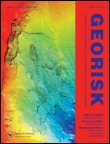
Georisk-Assessment and Management of Risk for Engineered Systems and Geohazards
Scope & Guideline
Elevating Standards in Geotechnical Safety and Reliability
Introduction
Aims and Scopes
- Geotechnical Risk Assessment:
Investigating and quantifying risks associated with geotechnical systems, including foundations, slopes, and earth structures, using probabilistic models and reliability analysis. - Geohazard Management:
Focusing on the assessment and mitigation of natural hazards such as landslides, floods, and earthquakes, emphasizing predictive modeling and risk evaluation techniques. - Data-Driven Approaches:
Utilizing machine learning, artificial intelligence, and data analytics for site characterization, risk prediction, and the optimization of geotechnical designs. - Innovative Modeling Techniques:
Developing and applying advanced numerical and statistical methods to understand and predict the behavior of geotechnical systems under various conditions. - Integration of Multidisciplinary Knowledge:
Bringing together insights from geology, hydrology, and environmental science to enhance the understanding of geotechnical risks and develop comprehensive management strategies.
Trending and Emerging
- Machine Learning and AI Applications:
There is a significant increase in the use of machine learning and artificial intelligence for predictive modeling, risk assessment, and data analysis in geotechnics, reflecting the growing importance of these technologies in engineering practices. - Probabilistic and Stochastic Modeling:
A trend towards probabilistic and stochastic approaches in risk assessment is evident, allowing for better management of uncertainties associated with geotechnical systems and natural hazards. - Integrated Risk Management Frameworks:
Emerging themes emphasize the development of integrated frameworks that combine various methodologies and disciplines to address complex geotechnical risk scenarios. - Climate Change Impact Assessments:
Research focusing on the implications of climate change on geotechnical risks, such as landslides and flooding, is gaining traction, highlighting the importance of adaptive strategies in risk management. - Real-Time Monitoring and Data Assimilation:
The adoption of real-time monitoring technologies and data assimilation techniques for ongoing risk assessment is becoming more prominent, facilitating timely interventions and decision-making in geotechnical engineering.
Declining or Waning
- Traditional Geotechnical Testing Methods:
There is a noticeable decrease in publications focusing solely on conventional geotechnical testing methods, as researchers increasingly favor advanced data-driven and computational approaches. - Static Risk Assessment Models:
The reliance on static risk assessment models is waning, with publications increasingly emphasizing dynamic and probabilistic models that account for uncertainties and real-time data. - Simple Statistical Analysis:
The prevalence of basic statistical analyses is declining in favor of more complex and sophisticated techniques, such as machine learning and Bayesian methods, which provide deeper insights into geotechnical problems.
Similar Journals
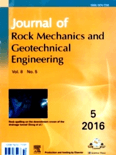
Journal of Rock Mechanics and Geotechnical Engineering
Pioneering Innovations in Rock Mechanics and Engineering GeologyThe Journal of Rock Mechanics and Geotechnical Engineering is a premier open-access publication dedicated to advancing the field of geotechnical engineering and engineering geology. Published by SCIENCE PRESS and based in China, this journal has been a vital resource for researchers and professionals since it transitioned to open access in 2013. With ISSN 1674-7755 and E-ISSN 2589-0417, it has established a global reputation, evidenced by its impressive Q1 ranking in the category of Geotechnical Engineering and Engineering Geology as well as a remarkable 8th rank out of 229 in Earth and Planetary Sciences, placing it in the 96th percentile according to Scopus. The journal aims to publish high-quality research that addresses contemporary challenges in the field, offering insightful perspectives and innovative solutions. Researchers, professionals, and students are encouraged to engage with the latest findings and methodologies published within its pages, which span from 2013 to 2024 and continue to pave the way for future advancements in geotechnical practices.

Geomechanics for Energy and the Environment
Advancing Research at the Intersection of Earth Sciences and Environmental ImpactGeomechanics for Energy and the Environment, published by ELSEVIER, stands as a premier journal in the fields of geotechnical engineering, Earth sciences, and risk assessment. With an impressive impact factor and ranking in the Q1 category across multiple relevant disciplines including Computers in Earth Sciences and Engineering Geology, this journal serves as a critical platform for groundbreaking research and innovation from 2015 to 2024. Located in the Netherlands, it aims to bridge the gap between geomechanics and energy solutions, making it indispensable for professionals and academics focused on sustainability and environmental impacts. Although it operates on a traditional access model, the rich and varied content published in this journal is essential for those at the forefront of research, helping to foster a deeper understanding of the interplay between geomechanical processes and environmental challenges. Your contributions to this journal not only enhance scientific dialogue but also pave the way for advancements in risk management and geotechnical practices that are crucial for the future.

EARTHQUAKE SPECTRA
Exploring the forefront of earthquake engineering research.EARTHQUAKE SPECTRA, published by SAGE PUBLICATIONS INC, is a premier journal dedicated to the field of geophysics, geotechnical engineering, and engineering geology, with a specific focus on seismic phenomena. Issued both in print (ISSN: 8755-2930) and electronically (E-ISSN: 1944-8201), the journal has maintained its position as a leading source of high-quality research since its inception in 1984. Recognized in the 2023 Category Quartiles as Q1 in both geophysics and geotechnical engineering, it is highly regarded in the academic community, ranking 11 out of 165 in its field, placing it in the 93rd percentile of Earth and Planetary Sciences, and 30 out of 229 for geotechnical engineering with an 87th percentile standing. With a commitment to advancing knowledge and practice in earthquake engineering, EARTHQUAKE SPECTRA publishes original research, case studies, and critical reviews that inform the design and construction practices related to seismic events. Although it does not currently offer open access, the journal's impact on the discipline remains significant, making it an essential resource for researchers, professionals, and students dedicated to understanding and mitigating the effects of earthquakes.

KSCE Journal of Civil Engineering
Elevating Research Standards in Civil EngineeringKSCE Journal of Civil Engineering is a prestigious international publication dedicated to advancing the field of civil engineering. Established by the Korean Society of Civil Engineers (KSCE), this journal serves as a vital platform for high-quality research in the discipline, showcasing innovative methodologies, case studies, and critical analyses pertinent to civil and structural engineering. With an impact factor placing it in the Q2 category of civil engineering journals for 2023 and a solid Scopus rank of #141 out of 379, it reflects the significant contributions of its authors and the growing recognition of its published works. KSCE Journal of Civil Engineering, based in Germany and easily accessible to the global research community, is committed to disseminating knowledge with rigor and integrity, encouraging both emerging scholars and seasoned experts to contribute to the evolving discourse in civil engineering. With a convergence period from 2009 to 2024, the journal continues to uphold its mission of fostering innovation and excellence in engineering practice.
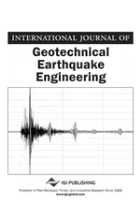
International Journal of Geotechnical Earthquake Engineering
Advancing seismic resilience through innovative geotechnical research.International Journal of Geotechnical Earthquake Engineering, published by IGI Global, serves as a pivotal platform for researchers and practitioners in the field of geotechnical engineering and engineering geology. Established in 2010, this journal has steadily promoted the dissemination of innovative research and advancements in understanding the impact of seismic activities on soil behavior and structural integrity. Operating out of the United States, it caters to a global audience and offers a range of articles that delve deep into the dynamics of earthquake engineering. With a 2023 Scopus ranking placing it in the 39th percentile among its peers and a Q4 designation in the relevant quartile, the journal actively seeks to elevate the discussion around geotechnical challenges associated with seismic events. While currently not classified as an Open Access journal, it remains committed to providing valuable insights that aid in the prevention and mitigation of geotechnical failures during earthquakes. Researchers, professionals, and students alike will find this journal an essential resource for the latest developments and practical applications in this ever-evolving field.
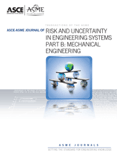
ASCE-ASME Journal of Risk and Uncertainty in Engineering Systems Part B-Mechanical Engineering
Innovating Risk Assessment for Engineering ExcellenceASCE-ASME Journal of Risk and Uncertainty in Engineering Systems Part B-Mechanical Engineering, published by the reputable ASME, is a leading platform dedicated to advancing knowledge in the field of mechanical engineering with a particular emphasis on risk assessment and uncertainty analysis. With an ISSN of 2332-9017 and an E-ISSN of 2332-9025, this journal has established itself as a significant contributor to ongoing research in safety, risk, and reliability, consistently ranking in the Q2 quartile for Mechanical Engineering as well as Safety Research categories. As evidenced by its impressive Scopus rankings—including a notable 80th percentile in Safety Research—this journal fosters high-quality research that informs engineering practices and enhances safety protocols. Operating under a traditional access model, it aims to provide researchers, professionals, and students with essential insights and methodologies to address contemporary challenges in engineering systems. Each contribution reflects an aim to bridge theory and application, thus making the journal an invaluable resource for stakeholders striving for excellence in mechanical engineering and safety management.
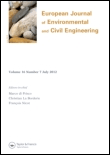
European Journal of Environmental and Civil Engineering
Innovating Engineering Practices for a Greener TomorrowThe European Journal of Environmental and Civil Engineering, published by Taylor & Francis Ltd, is a prestigious peer-reviewed journal that serves as a vital platform for advancing knowledge in the fields of Civil and Structural Engineering as well as Environmental Engineering. With an impressive impact factor and categorized in the Q2 quartile for both engineering fields, this journal occupies a significant position in the scholarly community. Its focused scope encompasses innovative research, case studies, and practical applications that address contemporary environmental and infrastructural challenges. Researchers, professionals, and students alike benefit from the journal's commitment to high-quality discourse, as evidenced by its Scopus rankings, which place it in the top 30% in Civil and Structural Engineering and the top 40% in Environmental Engineering. Through the publication of cutting-edge studies and a commitment to fostering interdisciplinary dialogue, the European Journal of Environmental and Civil Engineering remains an essential resource for those dedicated to improving our built environment and safeguarding our natural resources.

Infrastructures
Connecting Scholars and Professionals in Engineering ExcellenceInfrastructures is a distinguished open-access journal, published by MDPI since 2016, dedicated to advancing the fields of engineering and construction through interdisciplinary research and critical insights. Based in Switzerland, it serves a global community of scholars and professionals, providing a platform for innovative studies that drive progress in Building and Construction, Civil and Structural Engineering, Computer Science Applications, Geotechnical Engineering and Engineering Geology, and various aspects of Materials Science. With an impressive impact factor and a positioning in the Q2 category across multiple engineering fields, the journal's robust ranking reflects its commitment to high-quality research, with notable Scopus rankings showcasing its significant contribution to academic discourse. Infrastructures not only facilitates open access to essential knowledge but also aims to bridge the gap between theory and practical application, making it an invaluable resource for researchers, industry professionals, and students alike.
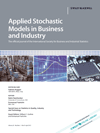
APPLIED STOCHASTIC MODELS IN BUSINESS AND INDUSTRY
Unlocking Insights Through Stochastic InnovationApplied Stochastic Models in Business and Industry, published by Wiley, is a preeminent journal dedicated to advancing the field of stochastic modeling in various business and industry contexts. With an ISSN of 1524-1904 and an E-ISSN of 1526-4025, this journal serves as a vital platform for researchers and practitioners aiming to leverage stochastic techniques to address complex decision-making and operational challenges. The journal holds prestigious rankings, including Q2 in Business, Management and Accounting, and has converged years spanning from 1999 to 2024. It is distinguished by its wide scope, focusing on all aspects of modeling and simulation, as well as decision sciences and operations research. Although it does not operate as an open-access journal, its significant impact factor and Scopus rankings ensure that the valuable insights published within reach a broad audience. By fostering high-quality research and discourse, Applied Stochastic Models in Business and Industry plays a crucial role in driving innovation and excellence in its fields.

Journal of Earthquake and Tsunami
Transforming geophysical research for a safer future.Welcome to the Journal of Earthquake and Tsunami, a premier scholarly publication dedicated to advancing the field of geophysical research, with a particular focus on seismic activity and tsunami phenomena. Published by World Scientific Publishing Co Pte Ltd, this journal provides a vibrant platform for researchers and practitioners alike to share their findings and innovations, contributing to the global understanding of these critical natural events. With an impact factor that reflects its relevance, the journal is categorized in Q3 quartiles for 2023 in areas including Geophysics, Geotechnical Engineering, and Oceanography, indicating a solid standing in the scientific community. It is indexed within Scopus, ranking in the upper half of its categories, which further establishes its importance as a resource for students and professionals seeking to stay informed about the latest developments. Although the journal operates under a traditional access model, its commitment to fostering scholarly discourse remains unwavering. Founded in 2008 and set to converge its offerings until 2024, the Journal of Earthquake and Tsunami continues to be an invaluable resource for anyone dedicated to understanding the dynamic and often dangerous interactions of our planet’s geological features.